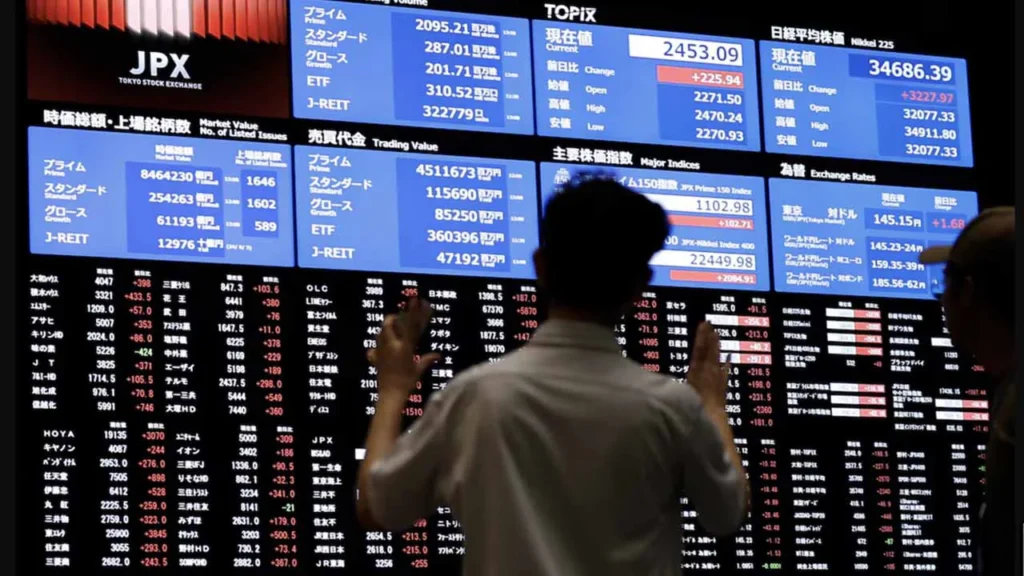- Web Desk
- Now

Dollar heads for monthly loss as Asian shares ease, US futures gain
-

- Reuters
- Yesterday

TOKYO: Asian shares eased on Tuesday, though US futures rose after President Donald Trump delayed his threatened 50 per cent duties on European Union shipments, while the dollar was headed for a fifth straight monthly loss.
In Japan, yields on super-long government bonds fell early in the session, retreating from their all-time highs in the wake of last week’s heavy selloff in the bonds.
Markets in the US were closed on Monday for a holiday, making for thin overnight trading conditions and leaving investors latching on to lingering optimism from Trump’s U-turn on his threat to impose 50 per cent tariffs on imports from the EU next month, restoring a July 9 deadline.
Nasdaq futures were up 1.26 per cent in Asia while S&P 500 futures similarly rose 1.11 per cent. FTSE futures advanced 0.94 per cent. UK markets were also closed on Monday.
“It was a better night for risk assets, following Trump deferring (EU tariffs) back to July 9,” said Tony Sycamore, a market analyst at IG.
“What I think probably is now the main driver for this week is we’ve got the month-end rebalancing flows, which should start to kick in anytime soon… Nvidia’s earnings report again is going to be front and centre in terms of what’s going on there.”
Results from Nvidia are due on Wednesday, where the AI darling is expected to report a 65.9 per cent jump in first-quarter revenue.
Elsewhere, MSCI’s broadest index of Asia-Pacific shares outside Japan was down 0.17 per cent, while Japan’s Nikkei similarly fell 0.15 per cent.
China’s CSI300 blue-chip index edged 0.06 per cent lower while the Shanghai Composite Index was little changed. Hong Kong’s Hang Seng Index dipped 0.1 per cent.
Focus for investors this week will also be on speeches from a slew of Federal Reserve policymakers and Friday’s US core PCE price index, for clues on the outlook for US rates.
A two-day annual conference hosted by the Bank of Japan (BOJ) and its affiliated think tank kicked off on Tuesday, with this year’s gathering of global central bankers in Tokyo set to focus on flagging economic growth and sticky inflation.
In currencies, the dollar struggled to find its footing and was headed for a fifth straight month of declines against a basket of currencies , which would mark the longest such losing streak since 2017.
The euro hovered near a one-month high at $1.14035, while the yen was up nearly 0.5 per cent at 142.18 per dollar.
Trump’s chaotic trade policies and concerns over the worsening US deficit outlook have undermined sentiment towards US assets and in turn been a drag on the dollar.
“A US dollar regime change could be in the making in the long term after it appears to have peaked recently,” said David Meier, an economist at Julius Baer.
“Erratic US policymaking, the tense fiscal situation, and large external indebtedness, against the backdrop of the twin deficit, suggest that a weaker USD is the route of least resistance.”
And as the dollar loses some of its safe-haven appeal, investors have instead sought alternatives such as gold, sending prices to record highs this year .
It last traded 0.28 per cent lower at $3,332.91 an ounce.
Elsewhere, oil prices eased on Tuesday as investors weighed the possibility of an OPEC+ decision to further increase its crude oil output at a meeting later this week.
Brent crude futures eased 0.1 per cent to $64.67 a barrel, while US West Texas Intermediate crude fell 0.16 per cent to $61.43 per barrel.
Read next: Crude prices ease amid speculation over OPEC+ supply increase





